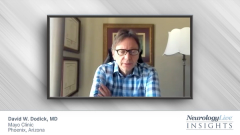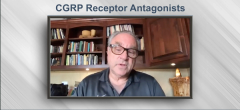
Acute Migraine Treatment: What’s Next?
Episodes in this series

David W. Dodick, MD: From an acute treatment standpoint, there’s nothing in phase 3 right now that looks groundbreaking. I’m just happy we have 2 new classes of medication that have been approved in the span of about a couple of months of each other after 30 years of having only triptans. I’m happy with the 2 classes that have been approved.
It’s going to take some time to really understand how these are performing in clinical practice and how to optimally use them in practice. The gepants facilitate treating patients differently. For example, I talked a little about the prodrome, where symptoms precede the headache. Obviously, if you had a medication that could be taken without adverse effects and without fear of medication overuse, because three-quarters of patients have prodromal symptoms before their head pain begins, we start to look at ways of using these acute treatments in ways they’ve never been used before. It would be great if we could actually prevent the headache from even happening in patients who have these symptoms that precede the pain or significantly attenuate or diminish the severity, such that they either spontaneously resolve after starting as mild pain or they respond within minutes of another acute treatment just while the pain is mild.
The gepants, in particular, usher in a new way to treat migraine acutely, with a new class of medication and a new target and because they can be used in patient populations for whom the use of triptans is contraindicated. But they may also usher in a new way to treat migraine entirely, by going even further at the beginning of the attack. I’m excited about that, and I hope to see future clinical trials evaluate that.
From an acute treatment standpoint, there’s nothing on the imminent horizon. There have been a couple of neuromodulation devices, using either vagus nerve stimulation or electrical stimulation outside that head. There’s another device that stimulates the trigeminal nerve here, and there is a device that uses magnetic stimulation. There are other techniques using different electrical or nerve stimulation modalities that can be used for acute treatment as well.
There’s nothing to say they can’t be used in conjunction with medicine. If the patient doesn’t respond optimally to either a device or to a medicine, maybe they would respond optimally to using them both together. Clearly, the mechanism of action will be different. Maybe we’ll see some combination trials there, looking at both the implementation of a device as well as a medication.
Newsletter
Keep your finger on the pulse of neurology—subscribe to NeurologyLive for expert interviews, new data, and breakthrough treatment updates.

































